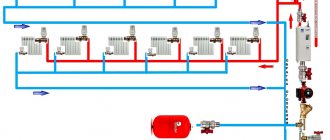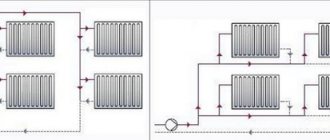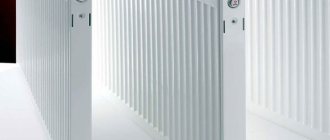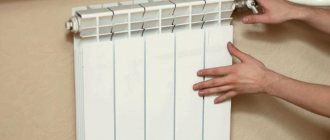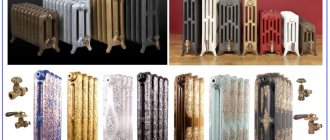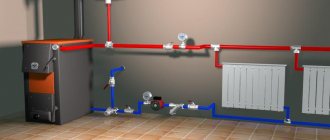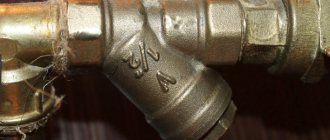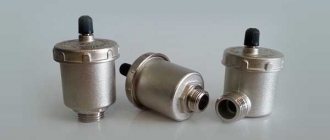Heating is a complex system with its own characteristics. Many people notice that their radiator is cold on the bottom and hot on the top. This problem should definitely be given attention. After all, in this case the radiator does not work at full capacity and, consequently, the temperature in the room drops. But if the temperature difference between the top and bottom of the radiator is small, then there is no need to worry. Let's take a closer look at the possible causes of this problem and ways to eliminate it.
Popular reasons
In almost all radiators, the temperature at the bottom is slightly lower than at the top. This depends on the high level of heat transfer. In this case, the water cools down before leaving the battery. With a small temperature difference, there is no cause for concern. A slight deviation is quite normal. But if you notice that the lower part of the radiator is barely warm or completely cold, then you should find out the reason and take measures to eliminate the problem.
- If you connect the radiator yourself, you can confuse the return and supply pipes. Also, if you use the services of an unqualified master, the following situation may arise. With such violations, the heating system is disrupted and the temperature at the bottom of the radiator drops.
- Low water circulation speed inside the radiator. This problem has a bad effect on battery performance. Due to the low speed, the temperature cools down before leaving the radiator. There can be many reasons for this speed. It needs to be identified and eliminated immediately.
Other reasons
The most popular reason is a decrease in the coolant flow rate. There are several options why this problem occurs:
- Narrow pipe section. Narrowing of the pipe can occur due to improper soldering of the pipes. This applies to polypropylene pipes. Another possible cause could be the presence of any deposits in the pipe. A common problem encountered is the installation of a control valve with a narrowed cross-section;
- In a heating system, the coolant moves at low speed. This problem occurs when the power of the circulation pump is low. In this case, the water does not move at the required speed and cannot go into the layer. This problem mainly occurs in gravity systems, in which there is no additional equipment;
- Low temperature in the house. In this case, the radiator cools faster, as it gives off a large amount of its energy. Therefore, the bottom of the radiator becomes colder than the top.
To identify the cause, the condition of the entire heating system should be assessed and checked. Once a problem is detected, it must be corrected for further normal operation of the radiator.
Pressure norm
Effective transfer and uniform distribution of coolant for the performance of the entire system with minimal heat loss is possible at normal operating pressure in the pipe lines.
The coolant pressure in the system is divided according to the method of action into types:
- Static. The force of influence of a stationary coolant per unit area.
- Dynamic. Force of action during movement.
- Maximum pressure. Corresponds to the optimal value of liquid pressure in the pipes and is capable of maintaining the operation of all heating devices at a normal level.
According to SNiP, the optimal indicator is 8-9.5 atm , reducing the pressure to 5-5.5 atm . often leads to heating interruptions.
For each specific home, the normal pressure indicator is individual. Its value is influenced by factors :
- power of the pumping system supplying coolant;
- pipeline diameter;
- remoteness of the room from the boiler equipment;
- wear of parts;
- pressure
Pressure control is possible using pressure gauges mounted directly into the pipeline.
Incorrect pipe connection
If the pipes are connected incorrectly, the efficiency of the radiator will decrease. Using the services of experienced craftsmen, such a problem does not arise. However, if you decide to connect the pipes yourself, then you may make a major mistake. When installing a radiator, the return pipe is often connected to the upper pipe, and the supply pipe to the lower pipe. This error causes the following problems:
- The efficiency of the system decreases and the water circulation is completely destroyed.
- The process of removing water from the battery is disrupted.
- Due to a decrease in battery efficiency and heat transfer, water cannot fill all sections evenly.
Water enters the radiator through the lower pipe. Then it flows in a circle and is discharged from the radiator. The work of the radiator is significantly reduced, since the sections do not warm up well. When connected to the upper pipe, liquid is not removed from the inside. This happens due to the characteristics of the radiator, which cannot create high pressure to remove water through the top.
Troubleshooting
If you find that your radiator is hot on top, but much colder on the bottom, then you should look for the reason. To do this, you need to perform a number of actions:
- Check the radiator connection. Have all the requirements been met when connecting the heating system?
- Bleed and clean.
- Check the condition of the control valves.
- Check the condition and connections of the pipes.
- Check the circulation pump. Replace it if damaged or install it.
If the pipes were not connected correctly, the bottom pipe will be hot. In this case, it is necessary to disconnect the pipes and reconnect them, but in the correct order. It will also be necessary to establish a work plan. If the pipes were routed correctly, the lower pipe will be slightly warm. In this case, there are no problems with connecting the pipes.
A common cause is the occurrence of air locks in the radiator. To avoid this problem, a special vent must be installed to remove air. You should shut off the supply, open the vent and remove the air. Then you need to turn off the tap and turn the heating valves.
If you do not have a circulation pump or it has low power, then the pressure in the heating system will be weak. And, therefore, the water will move slowly through the radiator. In this case, you need to purchase a powerful circulation pump.
If the heating system is equipped with a control valve, then this may be the cause of the problem. It needs to be removed and checked. If the cross-section is narrowed, you can increase it using tools. Or even replace it with a new faucet. After this, you can reinstall the element.
If none of the reasons listed above are a problem, then you should check the condition of the pipes. There may be various contaminants that need to be cleaned. If the pipes are severely damaged, then you need to buy new pipes.
After studying the article, you can independently identify the cause of the problem. After a thorough inspection of the radiator and elimination of the problem, you can establish high-quality operation of the heating system.
Often, residents of both apartment buildings and private houses are faced with the problem of cold radiators. In this article we will explain why this problem occurs and what to do if the batteries are cold.
Return is hot and supply is cold
Why is the return hot and the supply cold? This is a rare occurrence. It can be observed when the pump is installed in reverse and without a check valve. This is also possible due to the operation of the heated floor pump. When the floor is first started and heats the structure, it operates at full capacity and can, under certain circumstances, change the circulation in the radiator circuit. Once the floor warms up, it may go away on its own. If the pipes are hidden, then you need to check whether the pipes (supply and return) are mixed up. You can do it in different ways: with water or just blow.
Why do the batteries in the apartment not warm up well?
Reason 1: air locks

Often the radiators in the apartment are cold or not warm enough due to air locks. As a rule, this problem is relevant for residents of upper floors, since the air tends upward through the pipes. In order to eliminate air jams, a Mayevsky crane is used. It allows you to release the collected air and ensure full circulation of the coolant in the pipes.
Reason 2: non-optimal connection of heating batteries
Why do batteries in a private house not warm up well?
Just as in the case of a high-rise building, there may be several reasons for the poor performance of heating batteries in a private house.
Reason 1: problems in the hydraulics of the heating system
The most common reason why radiators remain cold is due to the hydraulics of the heating system. In this case, one of the heating branches is working properly, and the second is intermittent. This picture is typical for a new heating system or when adding radiators to an existing one. If the hydraulics are incorrectly calculated, and in particular the diameters and lengths of pipes, some batteries may simply not heat up. You can adjust the hydraulics using special taps.
Reason 2: single-pipe heating system
In many private homes there are single-pipe heating systems. In such a system, batteries remote from the boiler often heat much worse than those nearby. This does not mean that there are problems; this is the nature of the operation of a single-pipe system. The only solution here can only be to replace the system with a two-pipe one.
Reason 3: boiler malfunction
The batteries may not warm up due to malfunctions in boilers with built-in automation, pumps and sensors, which is a typical problem for autonomous heating systems. In this case, you must contact a specialist who works with such equipment directly.
How to install a radiator correctly?
Usually the radiator is installed under the window. There are several requirements that affect the quality of heat transfer from a heating device:
- the length of the battery must be at least 75% of the width of the window opening, and it must be installed exactly in the middle;
- if there is a window sill in the window design, then the radiator should be installed under it at a distance of 10-12 cm;
- The battery is mounted above the floor at a height of 10-12 cm;
- the clearance between the wall and the installed heating device should be 2-5 cm.
It should be noted that the indicated requirements are advisory. Some manufacturers offer to adhere to their installation parameters: they are usually specified in the product data sheet.
Now we need to find out what prevents radiators from 100% heat transfer. The following factors exist:
- If the window sill completely covers the battery from above, this guarantees a reduction in heat transfer efficiency by 5%.
- If the radiator is installed in a wall niche (that is, there is a wall ledge above it instead of a window sill), then the heat loss will be 7-8%.
- If a decorative screen is installed in front of the device, the heat transfer efficiency will decrease by 12%.
- If the installation is made in a niche and it is covered with a screen, then the losses will be up to 25%.
What to do if the bottom of the battery is colder than the top?
If the battery is hot on top and cold on the bottom, it is not functioning properly. In this case, diagnostics are required not only by the battery itself, but also by the entire heating system. The cause of the problem may lie in recent work on the heating system and replacement of the radiator. As a rule, the “hot top – cold bottom” problem appears due to an air lock (99% of cases) or a clogged radiator valve (a consequence of improper start-up of the system).
This problem is solved in two ways. You can remove the air lock using a Mayevsky tap or a bleeder. First of all, turn off the coolant supply to the radiator and leave the return line open. Open the drain, wait until the air comes out, close the drain and open the coolant supply. As a rule, this is enough.
If this method does not work, and we are talking about an apartment building, it is better to call a specialist. For private houses there is another option. First you need to turn off the heating supply, open the drain at the highest point of the system and use back pressure to squeeze out all the air.
Each heating system may have its own characteristics, and therefore there is a high probability of atypical problems arising. These include incorrectly selected pipe diameters, incorrect coolant distribution, poor throughput, lack of pressure, problems with the circulation pump or expansion tank. In any case, only a specialist can fully understand all the nuances, so in case of difficulties in solving the problem, it is better to seek help.
The heating system is a complex structure consisting of several elements combined into one circuit and put into operation through a chain reaction.
But it happens that the system fails and the water in the batteries becomes cold. The reason for this may be problems with the return line.
Collector - a system for everyone
This system is also called beam system. The essence of the scheme is this. In a heated room, usually closer to the center, there is a collector, from which two pipes go to each radiator - supply and return.
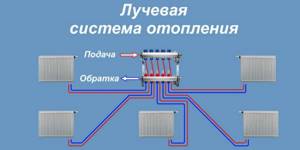
Pipes in it are usually used from metal-plastic or cross-linked polyethylene. They are most often laid in the floor structure (in a screed), less often along the ceiling of the lower floor. The beams approaching the radiators are of different lengths, so careful balancing is necessary for proper operation. The advantages of such a system are the absence of pipe connections located in the screed, since the beams are made from single pieces and the speed of installation. Moreover, the second advantage is quite controversial. The main disadvantage of such a system is its high cost - a large number of pipes and collectors cost money.
Causes of problems with return flow in the batteries of a private or apartment building
There are several reasons why the return flow is not warm enough or even cold. Common problems are:
- insufficient water pressure in the system;
- small section of the pipe through which the coolant passes;
- incorrect installation;
- airiness or contamination of the system.
If a problem with cold return occurs in an apartment, then the first thing you should pay attention to is the pressure. This is especially true for rooms on the upper floors . The fact is that the principle of operation of the return flow is to quickly and continuously circulate liquid through the system. And if its speed drops , then the coolant will not have time to push out cold water and the batteries will not heat up.
Another reason for malfunction of the return flow is contamination of the heating circuit. As a rule, major cleaning of systems in multi-storey buildings is not carried out often . The sediment that accumulates on the pipe walls over time prevents the passage of liquid.
The main reason for interruptions in the operation of the heating system in a private home is incorrect installation . Most often this happens when installation is carried out without the participation of specialists . Being incompetent in this matter, it is quite easy to confuse the supply and return pipes or choose pipes of the wrong size.
Both in an apartment and in a private house, the problem of a heating system malfunction may be associated with insufficient water supply or airiness . In a similar way, the operation of the return line is affected by contamination of the pipes.
Troubleshooting methods. Why is cleaning necessary?
To understand exactly how to solve a problem, you first need to establish its source. If the batteries become cold due to insufficient water circulation, installing a special pump . It will regularly push water into the circuit under a certain pressure, thereby preventing the system from stopping or slowing down.
Photo 2. Marking of the Grundfos circulation pump allows you to choose the most suitable one and install it correctly.
If the reason is that the pipes are clogged, then they just need to be cleaned . You can do this in several ways:
- using a water-pulsating mixture ;
- using biological products ;
- by means of pneumohydraulic hammer .
Important! Such cleaning is carried out regularly in order to prevent the emergence of new problems.
In the event of a malfunction resulting from improper installation of the equipment, contact a technician . A qualified specialist will certainly understand the problem and eliminate all problems. In addition, he will give practical advice and recommendations on the care and operation of the system.
Vertical and horizontal schemes
Horizontal and vertical schemes differ in the location of the pipes that connect the heating devices into the heating system.
- Horizontal two-pipe system - more suitable for one-story buildings of large length. In this case, the most reasonable option is to connect heating devices to a pipeline laid horizontally. This scheme is convenient for arranging a panel-frame house or for a house without walls, where the risers are best located in the corridor or on the staircase.
- Vertical two-pipe system - differs in that the devices are connected to a vertical riser. Installation of such a circuit will cost more, but it is more profitable in operation, since there will be no problems with air locks. This scheme is suitable for a multi-storey building, because each floor is connected to the riser separately.
Both of these schemes are characterized by good hydraulic and thermal stability. Only for a horizontal scheme will it be necessary to balance the horizontal loops, and for a vertical scheme, balancing of the vertical risers will be necessary.

